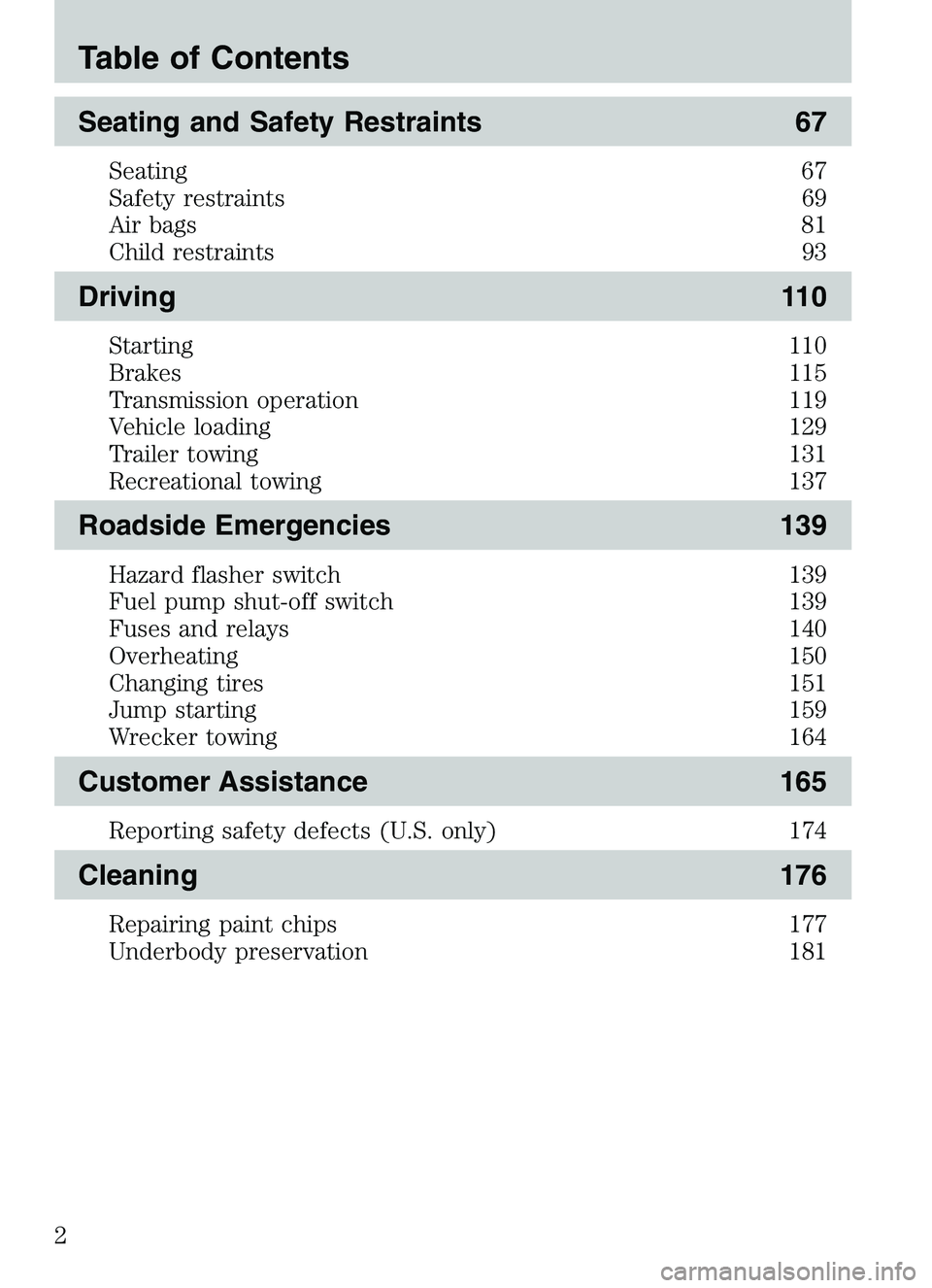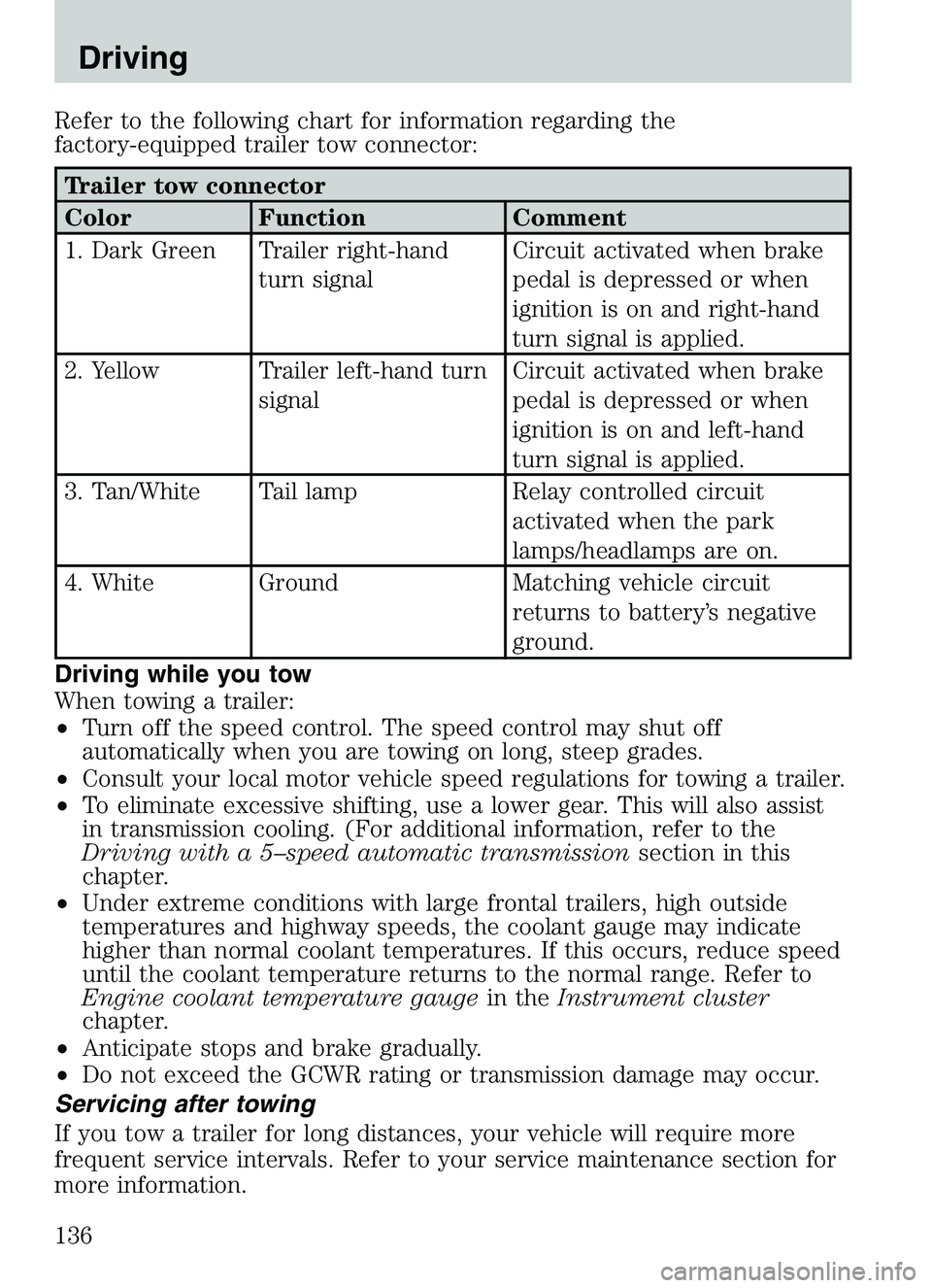relay MAZDA MODEL B4000 2003 Owners Manual
[x] Cancel search | Manufacturer: MAZDA, Model Year: 2003, Model line: MODEL B4000, Model: MAZDA MODEL B4000 2003Pages: 250, PDF Size: 2.85 MB
Page 2 of 250

Seating and Safety Restraints67
Seating 67
Safety restraints 69
Air bags 81
Child restraints 93
Driving110
Starting 110
Brakes 115
Transmission operation 119
Vehicle loading 129
Trailer towing 131
Recreational towing 137
Roadside Emergencies139
Hazard flasher switch 139
Fuel pump shut-off switch 139
Fuses and relays 140
Overheating 150
Changing tires 151
Jump starting 159
Wrecker towing 164
Customer Assistance165
Reporting safety defects (U.S. only) 174
Cleaning176
Repairing paint chips 177
Underbody preservation 181
Table of Contents
2
Page 119 of 250

AUTOMATIC TRANSMISSION OPERATION (IF EQUIPPED)
Brake-shift interlock
This vehicle is equipped with a brake-shift interlock feature that prevents
the gearshift lever from being moved from P (Park) when the ignition is
in the ON position unless the brake pedal is depressed.
If you cannot move the gearshift lever out of P (Park) with ignition in
the ON position and the brake pedal depressed:1. Apply the parking brake, turn ignition key to LOCK, then
remove the key.
2. Insert the key and turn it to OFF. Apply the brake pedal
and shift to N (Neutral).
WARNING: When the key is in the ignition OFF position, the
automatic transmission shift lever can be moved from the P
(Park) position without the brake pedal depressed. To avoid
unwanted vehicle movement, always set the parking brake. 3. Start the vehicle.
If it is necessary to use the above procedure to move the gearshift lever,
it is possible that a fuse has blown or the vehicle’s brakelamps are not
operating properly. Refer to Fuses and relaysin theRoadside
emergencies chapter.
WARNING: Do not drive your vehicle until you verify that the
brakelamps are working.
WARNING: Always set the parking brake fully and make sure
the gearshift is latched in P (Park). Turn the ignition to the
LOCK position and remove the key whenever you leave your
vehicle.
Driving
119
Page 136 of 250

Refer to the following chart for information regarding the
factory-equipped trailer tow connector:
Trailer tow connector
Color Function Comment
1. Dark Green Trailer right-handturn signal Circuit activated when brake
pedal is depressed or when
ignition is on and right-hand
turn signal is applied.
2. Yellow Trailer left-hand turn signal Circuit activated when brake
pedal is depressed or when
ignition is on and left-hand
turn signal is applied.
3. Tan/White Tail lamp Relay controlled circuit activated when the park
lamps/headlamps are on.
4. White Ground Matching vehicle circuit returns to battery’s negative
ground.
Driving while you tow
When towing a trailer:
• Turn off the speed control. The speed control may shut off
automatically when you are towing on long, steep grades.
• Consult your local motor vehicle speed regulations for towing a trailer.
• To eliminate excessive shifting, use a lower gear. This will also assist
in transmission cooling. (For additional information, refer to the
Driving with a 5–speed automatic transmission section in this
chapter.
• Under extreme conditions with large frontal trailers, high outside
temperatures and highway speeds, the coolant gauge may indicate
higher than normal coolant temperatures. If this occurs, reduce speed
until the coolant temperature returns to the normal range. Refer to
Engine coolant temperature gauge in theInstrument cluster
chapter.
• Anticipate stops and brake gradually.
• Do not exceed the GCWR rating or transmission damage may occur.
Servicing after towing
If you tow a trailer for long distances, your vehicle will require more
frequent service intervals. Refer to your service maintenance section for
more information.
Driving
136
Page 140 of 250

This switch is located in the front
passenger’s footwell, by the kick
panel access cover.
To reset the switch:1. Turn the ignition OFF.
2. Check the fuel system for leaks.
3. If no leaks are apparent, reset the switch by pushing in on the
reset button.
4. Turn the ignition ON.
5. Wait a few seconds and return the key to OFF.
6. Make another check of leaks.
FUSES AND RELAYS
Fuses
If electrical components in the
vehicle are not working, a fuse may
have blown. Blown fuses are
identified by a broken wire within
the fuse. Check the appropriate
fuses before replacing any electrical
components.
Note: Always replace a fuse with one that has the specified amperage
rating. Using a fuse with a higher amperage rating can cause severe wire
damage and could start a fire.
15
Roadside Emergencies
140
Page 142 of 250

To remove a fuse use the fuse puller tool provided.
The fuses are coded as follows:
Fuse/RelayLocation Fuse Amp
Rating Passenger Compartment Fuse
Panel Description
1 5A Power mirror switch
2 10A Daytime Running Lights (DRL), Back-up lamps, Transmission,
Passenger air bag deactivation
switch, Blower motor relay
3 7.5A Left stop/turn trailer tow connector
4 — Not used
5 15A 4x4 control module
6 2A Brake pressure switch
7 7.5A Right stop/turn trailer tow connector
Roadside Emergencies
142
Page 143 of 250

Fuse/RelayLocation Fuse Amp
Rating Passenger Compartment Fuse
Panel Description
8 — Not used
9 7.5A Brake pedal position switch
10 7.5A Speed control servo/amplifier assembly, Generic Electronic
Module (GEM), Shift lock
actuator, Turn signals, 4x4
11 7.5A Instrument cluster, 4x4, Main light switch, Central Security Module
(CSM), Generic Electronic Module
(GEM)
12 — Not used
13 20A Brake pedal position switch
14 10A Anti-lock Brake System (ABS) control module
15 — Not used
16 30A Windshield wiper motor, Wiper HI/LO relay, Wiper run/park relay
17 20A Cigar lighter, Data Link Connector (DLC)
18 — Not used
19 25A Powertrain Control Module (PCM) power diode, Ignition, PATS
(Passive Anti-Theft System)
20 7.5A Generic Electronic Module (GEM), Radio
21 15A Hazard flasher
22 20A Auxiliary power socket
23 — Not used
24 7.5A Clutch Pedal Position (CPP) switch, Starter interrupt relay
25 — Not used
Roadside Emergencies
143
Page 144 of 250

Fuse/RelayLocation Fuse Amp
Rating Passenger Compartment Fuse
Panel Description
26 10A Battery saver relay, Auxiliary relay box, Restraint Central Module
(RCM), Generic Electronic
Module (GEM), Instrument
cluster
27 — Not used
28 7.5A Generic Electronic Module (GEM), Radio
29 20A Radio
30 — Not used
31 — Not used
32 — Not used
33 15A Headlamps, Daytime Running Lamps (DRL) module, Instrument
cluster
34 — Not used
35 15A Horn relay (if not equipped with a Central Security Module)
36 — Not used
Power distribution box
The power distribution box is
located in the engine compartment.
The power distribution box contains
high-current fuses that protect your
vehicle’s main electrical systems
from overloads.
WARNING: Always disconnect the battery before servicing high
current fuses.
Roadside Emergencies
144
Page 145 of 250

WARNING: To reduce risk of electrical shock, always replace
the cover to the Power Distribution Box before reconnecting
the battery or refilling fluid reservoirs.
If the battery has been disconnected and reconnected, refer to the
Battery section of the Maintenance and specifications chapter.
2.3L engine (if equipped)
The high-current fuses are coded as follows:
Fuse/Relay Location Fuse Amp
Rating Power Distribution Box
Description
1 50A** I/P fuse panel
2 — Not used
3 — Not used
4 — Not used
5 — Not used
6 50A** Anti-lock Brake System (ABS)
pump motor
7 30A* Powertrain Control Module (PCM)
1234521 22 23 24
25 26 27 28
29 30 31 32
33 34 35 36
37 38 39 40
41 42 43 44
678910 55
49
48 54
5352
51 56
56 B
56 A
50 50 B
50 A
47
45 45 B
45 A
4646 B
46 A
11 12 13 14 15
16 17 18 19 20
Roadside Emergencies
145
Page 146 of 250

Fuse/RelayLocation Fuse Amp
Rating Power Distribution Box
Description
8 20A* Central security module, Power
door locks, Remote entry
9 — Not used
10 — Not used
11 50A** Starter relay, Ignition switch
12 20A* Power windows
13 — Not used
14 — Not used
15 — Not used
16 40A** Blower motor
17 20A** Auxiliary cooling fan
18 — Not used
19 — Not used
20 — Not used
21 10A* PCM memory
22 — Not used
23 20A* Fuel pump motor
24 30A* Headlamps
25 10A* A/C clutch relay
26 — Not used
27 — Not used
28 30A* ABS module
29 — Not used
30 15A* Trailer Tow
31 20A* Foglamp, Daytime Running Lamps
(DRL)
32 — Not used
33 15A* Park lamp, Central security
module
34 — Not used
35 — Not used
Roadside Emergencies
146
Page 147 of 250

Fuse/RelayLocation Fuse Amp
Rating Power Distribution Box
Description
36 — Not used
37 — Not used
38 10A* Left headlamp low beam
39 — Not used
40 — Not used
41 20A* Heated oxygen sensors
42 10A* Right headlamp low beam
43 — (Resistor)
44 — Not used
45A — Wiper HI/LO relay 45B — Wiper park/run relay
46A — Fuel pump relay 46B — Trailer tow relay 47 — Starter relay
48 — Auxiliary cooling fan relay
49 — Not used
50 — Not used
51 — Not used
52 — Not used
53 — PCM Diode
54 — PCM Relay
55 — Blower motor relay
56A — A/C clutch relay 56B — Front washer pump relay
* Mini Fuses ** Maxi Fuses
Roadside Emergencies
147